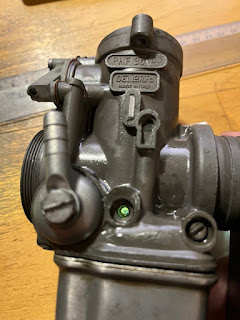So I bought a Guzzi. Not just any Guzzi, a really ugly one. A 1992
California 3 model, which had been (more or less) skillfully customised and
then dropped at least once, as the left forward control was rather bent and so
was the dashboard housing.
Matters of taste aside, under the rather voluptous rear mudguard one could clearly see a pair of Konis poke out, there was nothing obviously rusty and the last time it has run, it was mostly on the left side cylinder.
So the obvious question is: why buy a bike, which does not visually appeal, has been crashed and you appear to only have bad things to say about? Well, let me start with pointing out that even though I have never owned a Guzzi before, I worked on quite a lot of them already, from early V7 to LM5s and quite a few in between and there's one thing you have to know about them (unless you know already): All Tonti framed Guzzis are built equal. (Which is technically not entirely true, as for example a California 2 and 3 will have a different headstock, which makes it more stable in a straight line and lots and lots of brackets are in different spots, etc.) Thus, in theory and with a bit of effort you can build (almost) any Tonti-frame Guzzi out of another Guzzi. Knowing that they are essentially Lego, I wanted a California 3 for one primary reason:
That's right, this is the final (and in my opinion ultimate) evolution of the classic two valve Guzzi engine sporting 1000cc, but in the low(er) compression variant and with a heavy fly wheel, meaning relatively humble 70(-ish) horsepower on paper, but enough low end torque to make a dump truck blush.
As delivery was part of the deal, I was in the interesting situation to have the paperwork and carbs (and a few other assorted small bits) with me, before the bike even arrived.
It was rather apparent, that one of the reasons, why the last guy had given up, was because he had bought a handful of mismatched parts, when attempting to fix the carbs in order to get the bike back on the road.
After picking up quite a few carb parts here and there and checking the carb housings for damage, it was pretty obvious that they would need a bit of love, but were totally salvageable. (Also Dellorto PHF 36es have to be some of the most simple motorcycle carbs to rebuild.)
With the carbs sorted, it was a matter of finding out whether the electrical side of things was willing to come alive as well.
Anybody else thinking of Kubrick's Space Odyssey all of a sudden?
Install the carbs and improvise a fuel supply.
And lastly the oldest trick in the book, run some fine sandpaper through the points to clean them up.
The result is hardly surprising.
So with a running (-ish) and charging Guzzi it was more than time to tackle the elephant in the room and address the optical situation.














No comments:
Post a Comment